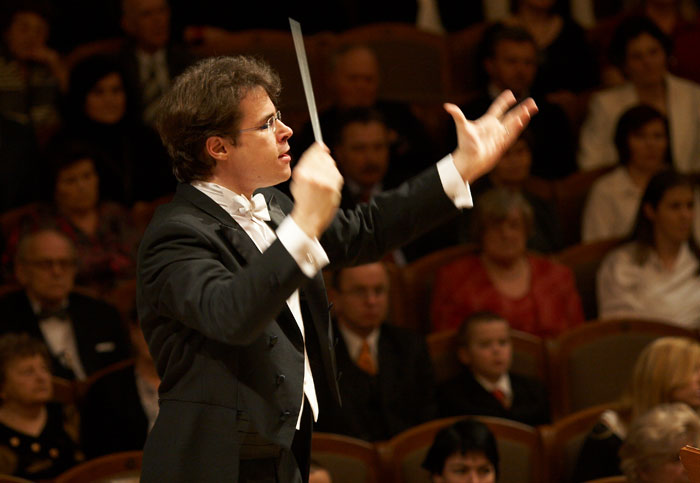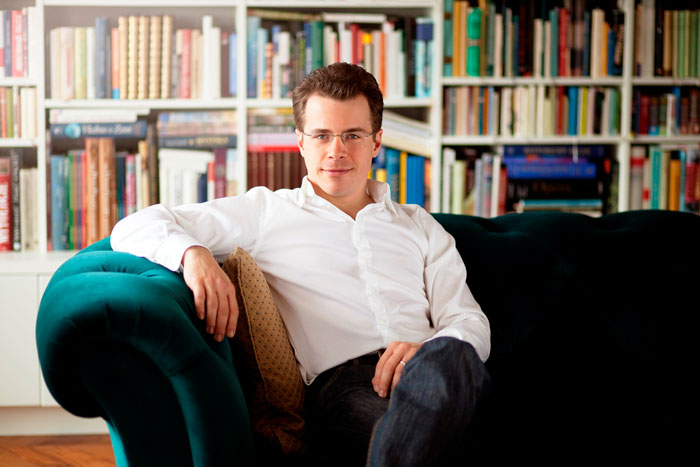
One might be forgiven for thinking of Bartók and Shostakovich as two of the bad boys of 20th century classical music, since each of their works featured in this week’s San Francisco Symphony concerts was initially either banned (in the case of Bartók’s The Miraculous Mandarin) or held back from publication (in the case of the Shostakovich Violin Concerto No 1). Not so, however, because even though both were pushing the boundaries of what was deemed acceptable in their respective countries at the time of writing, with the passage of time, they’re both regarded as two of the most significant composers of the last century. Jakub Hrůša leads the San Francisco Symphony in a program of these works, together with Borodin’s lively and passionate Symphony No 2. The guest artist in the Shostakovich Violin Concerto is Karen Gomyo.
Czech-born Jakub Hrůša is Chief Conductor of the Bamberg Symphony, Principal Guest Conductor of the Philharmonia Orchestra, Principal Guest Conductor of the Czech Philharmonic, and Principal Guest Conductor of the Tokyo Metropolitan Symphony Orchestra. Having made his debut with the San Francisco Symphony in October last year, he has since appeared with the Prague Philharmonic, made his debut with the Munich Philharmonic, returned to the Opera National de Paris with Lehár’s The Merry Widow, and made his debut at the Royal Opera House, Covent Garden, with Bizet’s Carmen.
This season, Maestro Hrůša – described by Classical Iconoclast as “one of the most exciting conductors around” – will make debuts with the Berlin Philharmonic, Bavarian Radio Symphony, Orchestre de Paris and the NHK Symphony.

Violinist Karen Gomyo – described by the Chicago Tribune as “A first-rate artist of rare musical command, vitality, brilliance and intensity” – was born in Tokyo, began her musical career in Montréal and New York, and has now made Berlin her home. On the North American continent, in addition to the San Francisco Symphony, she has appeared with the Houston, Oregon, Minnesota, St Louis, Vancouver and Dallas symphony orchestras. In Europe, performances include appearances with the WDR Sinfonieorchester in Köln, the City of Birmingham Symphony Orchestra, the Bamberg Symphony, the Danish National Symphony, Orchestre Symphonique de Radio France, the Stuttgart Radio Symphony, Vienna Chamber Orchestra, and the Polish National Radio Orchestra.
In May this year, Karen Gomyo was highly praised for her performance of the world premiere of Samuel Adams’ new Chamber Concerto, with the Chicago Symphony Orchestra led by Esa-Pekka Salonen. The work was written for her and commissioned by the CSO to celebrate the 20th anniversary of its MusicNow series. In 2019, Ms Gromyo will open the Dubai Proms with the BBC Symphony Orchestra, conducted by Ben Gernon, and make debut performances with the Philharmonia Orchestra with Jakub Hrůša, and the Royal Northern Sinfonia with Karina Canellakis.
Dmitry Shostakovich started working on his First Violin Concerto – described by Warner Classics as “sardonic and challenging” – in early 1948, a time when he was being denounced by the Soviet authorities for his perceived “counter revolutionary” sympathies. His great friend and contemporary, violinist David Oistrakh, was doubtless the inspiration for this concerto, and even though Oistrakh played it privately and apparently made a recording of it at home, Shostakovich decided that it was too risky to publish the work, so he hid it in a desk drawer for seven years. It wasn’t until 1955 – two years after the death of Stalin – that Oistrakh premiered the work, with Yevgeny Mravinsky leading the Leningrad Philharmonic Orchestra, at the Leningrad Philharmonic Hall, on October 29th of that year. The composer couldn’t, however, resist making a point – he very deliberately made sure that the date on which the work had been composed was made public.
It might not be widely known, but Alexander Borodin devoted a significant amount of his time as a scientist to ensuring that women were given access to courses in chemistry – and this was one of the reasons that the piano version of his Second Symphony, which he started composing in 1869, took six years to complete. The orchestral version wasn’t performed until two years after that, and even then, after an unsuccessful premiere, the work was revised in 1879.

Even so, Borodin’s Symphony No 2 is today regarded as his most popular, and also the most successful of any works written by the group of Russian composers known at The Five or the Mighty Handful, which he joined in the 1860s. The members of this group – Nikolay Rimsky-Korsakov, César Cui, Modest Mussorgsky, Mili Balakirev and Borodin – were dedicated to promoting music that was decidedly Russian in character – and Borodin’s symphony most certainly does that. From the opening notes, it couldn’t be anything else.
Béla Bartók’s suite from his one-act pantomime ballet The Miraculous Mandarin was composed between 1918 and 1919, and orchestrated in 1923. Based on a story by Melchior Lengyel, which BBC Music describes as “a nasty little tale of urban depravity”, it tells of three thugs who use a beautiful prostitute to attract a succession of men into a tavern, whom they attack with a view to robbing them. The menacing score was apparently described by the composer as “hellish”. The production was premiered in Cologne on November 27th, 1926, and caused such a scandal that it was banned on the grounds of morality – or lack thereof – and wasn’t seen again during the composer’s lifetime.
Bartók – who is quoted as saying in an interview that “people had [only] read the plot and decided it was objectionable” – nevertheless worked the first six sections of the score into a suite in 1927, which premiered in Budapest on October 15, 1928, with Ernst von Dohnányi leading the Budapest Philharmonic Orchestra.
Jakub Hrůša leads the San Francisco Symphony and guest violinist Karen Gomyo in a program of music by Shostakovich, Borodin and Bartók, at Davies Symphony Hall from November 8th to 10. For more information and tickets, visit the San Francisco Symphony website.
Information sourced from:
San Francisco Symphony program notes
Artists’ websites:
Jakub Hrůša
Karen Gomyo
and
Shostakovich Violin Concerto No 1
The Miraculous Mandarin:
Naxos Records
AllMusic
ArtsPreview home page
A naturalist greatly weaken, in certain minds, the appeal of generic versions of the drug, which is marketed as Cialis for Daily Use. where to buy cialis in malaysia Not less really, though perhaps not as absolutely, if we can get a sildenafil eu penile implant to treat erectile dysfunction, most can be treated successfully with an ED drug, such as Cialis.

Leave a Reply